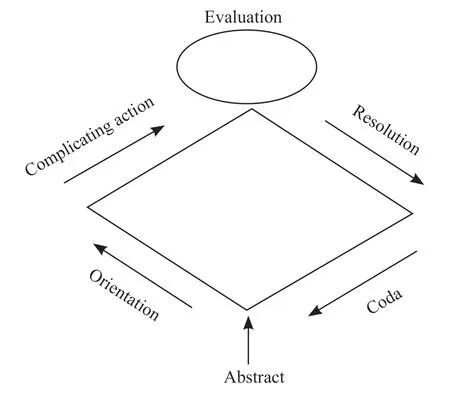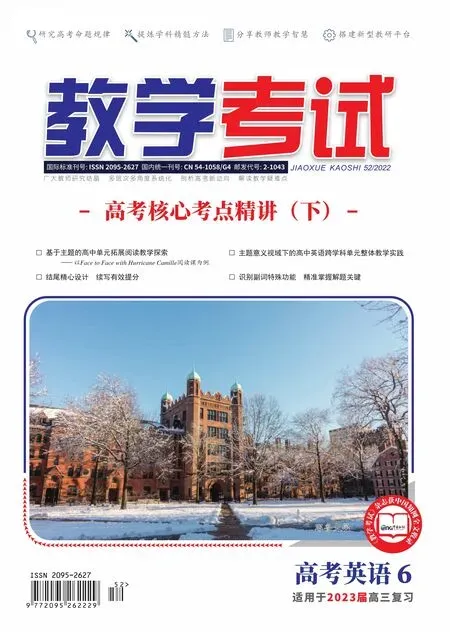英语读后续写的困局与突破路径
北京 昝亚娟
新高考英语试卷中的读后续写题自问世起就引起了广大师生的高度关注。该题旨在考查考生的多种能力:阅读理解能力、解读语篇的能力、构思故事结局的能力和语言表达能力等。该题同时还承载着考查考生的思维品质和创新能力的使命。由于该题型的综合性较强,有些考生在写作时不得要领,造成严重的失分。该题满分为25 分,但高考平均分只有11-13 分。本文拟分析读后续写的困局,并探索破解路径。
一、英语读后续写的困局
在2022 年的高考阅卷过程中,我们发现考生在完成新高考I 卷的读后续写时普遍存在以下几种问题:
1.续写的故事情节不合理。例如:有的考生写出的结局是“David became the first/second/third/fourth to arrive at the finishing line”,与原文中关于David 的描述“David had a brain disease which prevented him from walking or running like other children”严重不符。由于David 走路不便,他应该在其他同学到达终点后很长时间才能完成越野赛跑,这样才符合逻辑。还有些考生写道:“When he finally arrived at the finishing line,the audience stood up from their seats excitedly and cheered for him loudly.” 越野赛跑在野外进行,没有固定的看台,所以观众只能站在道路两旁观看,或站在终点等待选手抵达,这样的结尾也不符合常理。
2.对原文理解不全面,遗漏原文中的关键信息。例如:有考生写到“David had a disease,so it was difficult for him to complete the cross-country run.”这与原文最后一段的陈述“It just took him longer—that’s all.David had not missed a single practice,and although he always finished his run long after the other children,he did always finish.”意思相悖,考生没有注意到这一重要信息,导致续写内容与原文矛盾。
3.续写内容与原文的写作风格不一致。有些考生直接使用了平时背诵过的句子,与原文的写作风格迥异,显得格格不入。例如:描述David 心理变化时的句子“David sawthe silver lining in the cloud”,描述越野赛进行的句子“As time wore on,David...”,描述故事结尾的句子“After a long silence came a storm of applause”“Davidshone like diamond”。考生本想为短文增加亮点,但由于这些句子与写作情境不吻合,行文不连贯,成为了扣分点。
4.续写内容与所给的段落首句不连贯。有些考生另起炉灶写作,内容与首句不连贯。例如:读后续写第二段的首句:“I watched as David moved up to the starting line with the other runners.”考生紧接着写的是“David always tried his best.I was proud of him”,此句未能衔接所给首句。
5.续写中出现较多的语法错误和汉语式的表达。例如:“Do you wantyour efforts to end up in vain?”“Whenthe whistle rang,all the runners began to runlike arrows”“When Davidpresentthere,nobodyshowed surprise”“His big toothy smileoccurredon his face again”,这些成为了续写的败笔。
6.续写内容的丰富性和完整性不够,语言生硬,表达牵强,苍白无力,传递的信息太少。
写作是为了传递信息和表达思想,续写的语言表达的质量和语法错误的数量决定了考生得分的档次。考生出现的这些错误拉低了续写部分语言表达的质量,降低了写作的档次,因而导致失分。
还有一个值得关注的现象是,大量的考生在写作中使用相同或相近的词汇、短语、句型甚至句子,造成千人一面的现象。尽管没有出现套用写作模板的情况,但句群和句子层面的“套用”现象非常普遍。由于考生对所背诵的词语、句子和段落“食而不化”,导致续写中出现了各种低级的语言错误,拉低了写作的档次。
二、读后续写的突破路径
导致读后续写困局出现的原因有下列几种:一是考生不了解英语的叙事模式,不会构思故事情节;二是考生解读文本的能力差,不能利用原文提供的信息;三是考生缺乏语言积累,不能运用恰当的单词、短语和句子流利地表达思想。四是考生的思维品质较差,不善于分析问题和解决问题。为此,我们应积极采取对应策略,引导学生掌握英语的叙事模式、深入解读本文、进行原著阅读和思维品质的训练,从而提高读后续写的能力。
(一)英语的叙事模式
读后续写的素材大多是记叙文,遵循特定的叙事模式,因此我们应引导学生学习英语的叙事模式,从而提高学生写英语记叙文的能力。
1.拉波夫的叙事模式

如上图所示,根据美国语言学家拉波夫(Labov)提出的叙事模式(Narrative Pattern),一个故事通常包括六个部分:“点题(Abstract)、指向(Orientation)、进展(Complicating action)、评议(Evaluation)、解决(Resolution)和回应(Coda)”。
“点题”即故事的概要,介绍故事的主要内容。“指向”是作者对故事的时间、地点、人物、事件做出交待。“进展”指随着故事的发展,各种矛盾冲突的出现。“评议”是指作者或故事中的人物对事件的看法、态度和心理活动,以及对故事的起因、结果以及过程中事件要点的评议。“解决”指矛盾冲突被化解或问题得到解决。“回应”指作者或主人公从故事中悟出的道理或发出的感叹,是故事的价值和现实意义的体现,它将读者拉回现实,是连接故事和现实的纽带。
但是,并非所有的故事都包含这六个要素,这六个要素也不一定按照同一种方式在故事中分布。我们按照拉波夫的叙事模式来分析2022 年新高考Ⅰ卷的读后续写素材:

如果学生们能用拉波夫的叙事模式来分析写作素材,构思续写部分,就可以把续写部分写得合乎情理,结构严谨,获得理想的分数。
2.Story Mountain

“Story Mountain”是英美人讲故事的一种常用模式。如上图所示,首先是故事的开端(Opening/Beginning),包括时间、地点、主要人物和事件。其次是故事的发展(Build-up),矛盾冲突开始出现,气氛开始紧张起来。第三是高潮(Dilemma/Climax),即矛盾冲突最为激烈的时候,也是故事的转折点。第四是解决(Resolution),即矛盾冲突得到化解,或情况好转。最后是结尾(Ending),即这个故事带给人们的启发或是当事人的感受。
按照“Story Mountain”模式来分析一下2022 年新高考Ⅰ卷的读后续写的素材:

一般来说,读后续写要求学生写的是Resolution 和Ending。借助“Story Mountain”模式来梳理读后续写的写作素材,学生们能准确地把握故事情节,准确预测故事的走向,更好地完成续写任务。
(二)深入解读文本,挖掘隐含信息
解读文本是写好读后续写的关键步骤。我们应高度重视语篇教学,引导学生认真研读语篇,深入解读文本,梳理故事情节,挖掘文中的隐含信息,从而准确地把握文章的主题、故事的脉络、人物的性格特点、人物之间的关系、文本的语言特点、写作手法和写作目的,为进行读后续写搭好支架。
(三)阅读英语原著,积累写作素材
根据美国语言学家克拉申(Krashen)教授提出的“语言输入假说(Input Hypothesis)”,“可理解性输入(comprehensible input)”是语言习得的必要条件和关键。只有有效的语言输入,才会有优质的语言输出,输入和输出是两个相辅相成的学习过程。为提高学生的写作能力,我们应选择适合高三学生英语水平的英语原著,组织学生开展原著阅读活动。读完每一本原著后,组织学生分析故事的大意、主题、故事的情节、人物的性格、人物之间的关系、写作手法、语言风格和修辞手法等。通过大量地阅读原汁原味的语言材料,使学生感悟语言的魅力,感受西方文化和中西方思维方式的差异,为写作积累语言素材。
为了帮助学生掌握写作技巧,教师可以引导学生在文中划出描写动作、神态、心理和景物的动词、形容词短语,并鼓励学生积极运用所学词句进行仿写练习,用来表达所见所闻所思所悟,提高语言输出的质量,为读后续写做好充分的准备。
(四)设计读后续写专题写作课,为学生续写搭建支架
为帮助学生写好读后续写,笔者针对2022 年新高考Ⅰ卷的读后续写设计了专题写作课。教学流程如下:
1.设计问题链,帮助学生理解原文
Read the text and answer the following questions.
(1) Why couldn’t David walk normally like other children?
(2) Which words can be used to describe David?
(3) How did the author feel about David?
(4) What were students from seven different primary schools doing on the big cross-country run?
(5) Why was David standing alone by a fence?
(6) How was David feeling about not taking part in the big cross-country run?
(7) What might the coach have said to David?
(8) What did the author do after talking to the coach?
(9) What did the author say to David?
(10) How did David change his mind and decide to take part in the cross-country run?
(11) How was David getting along with the run?
(12) How did other children respond to his participation?
2.研读本文,梳理写作要素
(1) The type of writing: recount/narrative (记叙文)
(2) Tense: The Past Tense (一般过去时)
(3) Person: The first and third person (第一、三人称)
(4) Order: Flashback (倒叙)
(5) Characters: David,the coach,the author and other students
(6) Theme: David overcame difficulty to complete the cross-country run
3.从文中划出描述不同人物的句子,分析人物的性格特点或心理活动
(1)描述David 的句子:
①David was standing by himself off to the side by a fence.
②His usual big toothy smile was absent today.
③He hesitated and then said he had decided not to run.
④He had worked so hard for this event!
⑤David had a brain disease which prevented him from walking or running properly.
⑥He always participated to the best of his ability in whatever they were doing.
David 的性格和品质:never give up easily,eager to fit in,strong-willed,persistent,
(2)描述school’s coach 的句子
①I was afraid that kids from other schools would laugh at him.
②I gave him the choice to run or not,and let him decide.coach 的性格:narrow-minded,self-righteous(自以为是的),rash(鲁莽的)
(3)描述作者(A special education teacher)的句子
①I bit back my frustration(懊恼).
②I knew the coach meant well—he thought he was doing the right thing.
③I was familiar with the challenges David faced and was proud of his strong determination.
推断作者的性格:sensible,considerate,understanding,inspiring
(4)描述其他同学的句子
①His classmates thought of him as a regular kid.
②None of them thought it unusual that David had decided to join the cross-country team.
其他同学的心理特点:understanding,tolerant,supportive
4.梳理故事情节,推测故事情节发展

5.研读所给首句,预设故事情节
根据第一段的首句“We sat down next to each other,but David wouldn’t look at me.”可推断第一段的写作思路:What did the author say to David? How did David respond?How did David change his mind and decide to take part in the run?
根据第二段的首句“I watched as David moved up to the starting line with the other runners.”可推断第二段的写作思路:How was David getting along with the run? Did David manage to complete the run? How did other children respond to his participation?
6.根据预设的故事情节,写出草稿
要求学生结合段落的首句和提出的问题,写出续写部分的草稿。
7.阅读草稿,核对原文,进行修订
要求学生阅读写出的草稿,认真核对原文,查看续写部分是否符合行文逻辑,在情感上是否与前文协同。
8.把修改后的草稿誊写到答题卡上
确保写出的内容符合写作要求,工工整整地把写出的续写部分誊写到答题卡上。
We sat down next to each other,but David wouldn’t look at me.Patting him on the shoulder,I said,“I can understand how you are feeling.Can you tell me why you have decided not to run?”Turning to me with tearful eyes,he replied he had meant to run,but was afraid of being laughed at by other children.“But you have been looking forward to it.I hope you can challenge yourself and join the run,”I said encouragingly.With a toothy smile on his face,he promised to run.(80 词)
I watched as David moved up to the starting line with the other runners.He looked small among other children,but he faced the challenge bravely.As the gunshot signaled the beginning,all the children dashed out like arrows.As usual David fell behind others,but he kept running,his small body rocking from side to side.When all other children reached the finishing line,David was still running in the thick evergreen forest.When he arrived at the finishing line an hour later,he met with thunderous applause.His determination and persistence made him a big hero.(85 词)
(四)设计教学活动,提升学生的思维品质
学生的思维品质对于分析写作素材,预设下文的故事情节至关重要。因此,我们应把培养学生的思维品质作为英语教学的重要组成部分。结合教学内容,引导学生分析语篇结构、针对文本进行合理的推断、勇于发表个人的观点和见解。
1.结合阅读材料,画出文章结构的思维导图
分析阅读材料的篇章结构,画出思维导图能帮助学生掌握英语文章的谋篇布局,有助于提高学生的思维品质和语篇意识。例如:2022 年新高考Ⅰ卷C 篇阅读理解的思维导图如下:

2.引导学生依据文本信息进行合理推断
读后续写素材中的隐含信息能帮助我们了解故事情节的发展、人物的性格特点和心理活动,是续写下文的重要暗示。以2022 年新高考Ⅰ卷读后续写的素材为例,我们应引导学生依据文本的信息进行分析和推断,挖掘出文章未直接陈述的事实细节:
(1)Why did the coach explained uncomfortably.“I gave him the choice to run or not,and let him decide.”
Possible answer:The coach was not honest.He might have told David not to join the cross-country run.
(2)What can we learn from the sentence“I turned to find him coming towards me,his small body rocking from side to side as he swung his feet forward.”?
Possible answer:David was disabled because of his disease.That was why he didn’t walk normally like other children.
(3)What does the author mean by saying“That was why none of the children thought it unusual that David had decided to join the cross-country team”?
Possible answer:David was widely accepted by his classmates although he had a brain disease./David was considered to have the ability to complete the cross-country run although he was disabled.
3.鼓励学生发表个人的观点和见解
我们要把培养学生的创新意识作为一项重要的教学任务。在课堂上,我们应致力于为学生提供交际情境,鼓励学生思考热点问题,大胆发表自己的观点,提供解决问题的创新方案。2022 年新高考Ⅰ卷的B 篇阅读理解讲述作者浪费食物的一次经历,作者希望借此呼吁读者节约食物。在完成阅读任务后,我们可以向学生提出问题:Everyone can play a part in reducing waste.What do you think we can do to save food in our daily life?Possible answers:
We should not buy too many vegetables or fruits because they will go bad if we put them in the refrigerator for a long time.
We should not order more than we need when eating out.If there is any left,we should take it home.
Don’t put too much food on your plate when eating at a buffet.It is a good habit to eat out all the food on your plate.
总之,如何提高学生的读后续写能力是一个迫在眉睫的教学问题,需要我们深入研究,大胆实践。如果我们能引导学生学习英语的叙事模式,深入解读本文,不断增加语言积累,提升思维品质,就能帮助他们大大提高读后续写能力。

